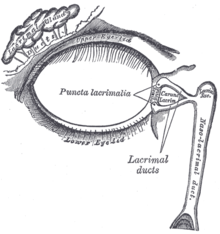- Crying
-
"Cry" redirects here. For other uses, see Cry (disambiguation).This article is about the human shedding of tears. For other uses, see Crying (disambiguation).
Crying (also called sobbing, weeping, bawling, and blubbering) is shedding tears as a response to an emotional state in humans. The act of crying has been defined as "a complex secretomotor phenomenon characterized by the shedding of tears from the lacrimal apparatus, without any irritation of the ocular structures".[1] The medical term for this is to lacrimate, which also refers to non-emotional shedding of tears.
A neuronal connection between the lacrimal gland (tear duct) and the areas of the human brain involved with emotion has been established. Some scientists believe that only humans produce tears in response to emotional states [2] while others disagree.[3] Charles Darwin wrote in The Expression of the Emotions in Man and Animals that the keepers of Indian elephants in the London Zoo told him that their charges shed tears in sorrow.
In many cultures, it is more socially acceptable for women and children to cry, and less socially acceptable for men to cry.[2]
Tears produced during emotional crying have a chemical composition which differs from other types of tears. They contain significantly greater quantities of the hormones prolactin, adrenocorticotropic hormone, Leu-enkephalin[4] and the elements potassium and manganese.[2]
Contents
Function
 A young woman weeps during the deportation of Jews of Ioannina on March 25, 1944.
A young woman weeps during the deportation of Jews of Ioannina on March 25, 1944.
The question of the function or origin of emotional tears remains open. Theories range from the simple, such as response to inflicted pain, to the more complex, including nonverbal communication in order to elicit "helping" behavior from others.[5] Some have also claimed that crying can serve several biochemical purposes, such as relieving stress and releasing toxins from the body.[6] However, this view has recently come into question by psychologists who feel that the only reason people believe they think more clearly with a "good cry" is due to social influence. Also, individuals tend to remember the positive aspects of crying, and may create a link between other simultaneous positive events, such as resolving feelings of grief. Together these features of memory reinforce the idea that crying helped the individual.[7]
In Hippocratic and medieval medicine, tears were associated with the bodily humors, and crying was seen as purgation of excess humors from the brain.[8] William James thought of emotions as reflexes prior to rational thought, believing that the physiological response, as if to stress or irritation, is a precondition to cognitively becoming aware of emotions such as fear or anger.
William H. Frey II, a biochemist at the University of Minnesota, proposed that people feel "better" after crying, due to the elimination of hormones associated with stress, specifically adrenocorticotropic hormone.[9] This, paired with increased mucosal secretion during crying, could lead to a theory that crying is a mechanism developed in humans to dispose of this stress hormone when levels grow too high.
Recent psychological theories of crying emphasize the relationship of crying to the experience of perceived helplessness.[10] From this perspective, an underlying experience of helplessness can usually explain why people cry. For example, a person may cry after receiving surprisingly happy news, ostensibly because the person feels powerless or unable to influence what is happening.
Emotional tears have also been put into an evolutionary context. One study proposes that crying, by blurring vision, can handicap aggressive or defensive actions, and may function as a reliable signal of appeasement, need, or attachment.[11] Dr. Oren Hasson, an evolutionary psychologist in the zoology department at Tel Aviv University explains that crying shows vulnerability and submission to an attacker, solicits bystanders for sympathy and aid and signals shared emotional attachments.[12]
Another theory that follows evolutionary psychology is given by Paul D. MacLean, who suggests that the vocal part of crying was used first as a "separation cry" to help reunite parents and offspring. The tears, he speculates, are a result of a link between the development of the cerebrum and the discovery of fire. MacLean figures that since early humans must have relied heavily on fire, their eyes were frequently producing reflexive tears in response to the smoke. As humans evolved and began to say "Rest in Peace" to their dead, the smoke possibly gained a strong association with the loss of life and, therefore, sorrow.[13]
Biological response
It can be very difficult to observe biological effects of crying, especially considering many psychologists believe the environment in which a person cries can alter the experience of the crier. However, crying studies in laboratories have shown several physical effects of crying, such as increased heart rate, sweating, and slowed breathing. Although it appears that the type of effects an individual experiences depends largely on the individual, for many it seems that the calming effects of crying, such as slowed breathing, outlast the negative effects, which could explain why people remember crying as being helpful and beneficial.[14]
A common side effect of crying is feeling a lump in the throat of the crier, otherwise known as a globus sensation.[15] Although many things can cause a globus sensation, the one experienced in crying is a response to the stress experienced by the sympathetic nervous system. When an animal is threatened by some form of danger, the sympathetic nervous system triggers several processes to allow the animal to fight or flee. This includes shutting down unnecessary body functions, such as digestion, and increasing blood flow and oxygen to necessary muscles. When an individual experiences emotions such as sorrow, the sympathetic nervous system still responds in this way.[16] Another function increased by the sympathetic nervous system is breathing, which includes opening the throat in order to increase air flow. This is done by expanding the glottis, which allows more air to pass through. As an individual is undergoing this sympathetic response, eventually the parasympathetic nervous system attempts to undo the response by decreasing high stress activities and increasing recuperative processes, which includes running digestion. This involves swallowing, a processes which requires closing the fully expanded glottis to prevent food from entering the larynx. The glottis, however, attempts to remain open as an individual cries. This fight to close the glottis creates a sensation that feels like a lump in the individuals throat.[17]
Frequency of crying
According to a study of over 300 adults, on average men cry once every month; women cry at least five times per month,[2] especially before and during the menstrual cycle when crying can increase up to five times the normal rate, often without obvious reasons (such as depression or sadness).[18]
According to the German Society of Ophthalmology, which has collated different scientific studies on crying, women cry on average between 30 and 64 times a year, and men cry on average between 6 and 17 times per year.
Men tend to cry for between two and four minutes, and women cry for about six minutes. Crying turns into sobbing for women in 65% of cases, compared to just 6% for men. Until adolescence however, no difference between the sexes was found.[19]
Types of crying in infants
Although crying is an infant's mode of communication, it is not limited to a monotonous sound. There are three different types of cries apparent in infants. The first of these three is a basic cry, which is a systematic cry with a pattern of crying and silence. The basic cry starts with a cry coupled with a briefer silence, which is followed by a short high-pitched inspiratory whistle. Then, there is a brief silence followed by another cry. Hunger is a main stimulant of the basic cry. An anger cry is much like the basic cry; however, in this cry, more excess air is forced through the vocal cords, making it a louder, more abrupt cry. This type of cries is characterized by the same temporal sequence as the basic pattern but distinguished by differences in the length of the various phase components. The third cry is the pain cry, which, unlike the other two, has no preliminary moaning. The pain cry is one loud cry, followed by a period of breath holding. Most adults can determine whether an infant's cries signify anger or pain.[20] Most parents also have a better ability to distinguish their own infant's cries than those of a different child.[21] A 2009 study found that babies mimic their parents' pitch contour. French infants wail on a rising note while the Germans favor a falling melody.[22]
Categorizing dimensions
There have been many attempts to differentiate between the two distinct types of crying (one negative and one positive). Different perspectives have been broken down into three dimensions to examine the emotions being felt and also to grasp the contrast between the two types.[23]
Spatial perspective explains sad crying as reaching out to be "there," such as at home or with a person who may have just passed away. In contrast, joyful crying is acknowledging being "here." It emphasized the intense awareness of one's location, such as at a relative's wedding.[23]
Temporal perspective explains crying slightly differently. In temporal perspective, sorrowful crying is due to looking to the past with regret or to the future with dread. This illustrated crying as a result of losing someone and regretting not spending more time with them or being nervous about an upcoming event. Crying as a result of happiness would then be a response to a moment as if it is eternal; the person is frozen in a blissful, immortalized present.[23]
The last dimension is known as the public-private perspective. This describes the two types of cryings as ways to imply details about the self as known privately or one's public identity. For example, crying due to a loss is a message to the outside world that pleads for help with coping with internal sufferings. Or, as Arthur Schopenhauer suggested, sorrowful crying is a method of self-pity or self-regard, a way one comforts oneself. Joyful crying, in contrast, is in recognition of beauty, glory, or wonderfulness.[23]
Lacrimal system
 A diagram showing the lacrimal apparatus
A diagram showing the lacrimal apparatus
There are three types of tears: basal tears, reflexive tears, and psych tears. Basal tears are produced at a rate of about 1 to 2 microliters a minute, and are made in order to keep your eye lubricated and smooth out irregularities in the cornea. Reflexive tears are tears that are made in response to irritants to your eye, such as when chopping onions or getting poked in the eye. Psych tears are produced by the lacriminal system and are the tears expelled during emotional states.[24]
The lacrimal system is made up of a secretory system, which produces tears, and an excretory system, which drains the tears. The lacrimal gland is primarily responsible for producing emotional or reflexive tears. As tears are produced, some fluid evaporates between blinks, and some is drained through the lacrimal punctum. The tears that are drained through the punctum will eventually be drained through the nose. Any excess fluid that did not go into the punctum will fall over the eye lid, which produces tears that are cried. [25]
- Bell's palsy, where faulty regeneration of the facial nerve can cause sufferers to shed tears while eating.[26]
- Cri du chat, where the characteristic cry of affected infants, which is similar to that of a meowing kitten, is due to problems with the larynx and nervous system.
- Familial dysautonomia, where there can be a lack of overflow tears (alacrima) during emotional crying.[27]
- Pathological laughing and crying, where the patients experience relatively uncontrollable episodes of laughing or crying, or both.
References
- ^ Patel, V. (1993). "Crying behavior and psychiatric disorder in adults: a review". Compr Psychiatry 34 (3): 206–11. doi:10.1016/0010-440X(93)90049-A. PMID 8339540. http://linkinghub.elsevier.com/retrieve/pii/0010-440X(93)90049-A. Quoted by Michelle C.P. Hendriks, A.J.J.M. Vingerhoets in Crying: is it beneficial for one's well-being?
- ^ a b c d Walter, Chip (December 2006). "Why do we cry?". Scientific American Mind 17 (6): 44.
- ^ Langseth, Muriel; Frey, William H. (1985). "Ch. 14: Do Animals Shed Emotional Tears?". Crying: the mystery of tears. Minneapolis, Minn: Winston Press. pp. 135–9. ISBN 0-86683-829-5.
- ^ Skorucak A. "The Science of Tears." ScienceIQ.com.
- ^ "On the Origin of Crying and Tears". Human Ethology Newsletter 5 (10): 5–6. June 1989.
- ^ Doheny, Kathleen. "Why We Cry: The Truth About Tearing Up". WebMD. http://www.webmd.com/balance/features/why-we-cry-the-truth-about-tearing-up?page=2. Retrieved 23 June 2011.
- ^ Carey, Benedict (2 February 2009). "The Muddled Tracks of All Those Tears". The New York Times (The New York Times). http://www.nytimes.com/2009/02/03/health/03mind.html. Retrieved 18 July 2011.
- ^ Lutz (2001), 69ff.
- ^ "Crying; The Mystery of Tears" personal page of Frey WH with quote from his book
- ^ Miceli, M.; Castelfranchi, C. (2003). "Crying: discussing its basic reasons and uses". New Ideas in Psychology 21 (3): 247–73. doi:10.1016/j.newideapsych.2003.09.001.
- ^ New Theory for Why We Cry
- ^ "Why Cry? Evolutionary Biologists Show Crying Can Strengthen Relationships". Science Daily. Tel Aviv University.. http://www.sciencedaily.com/releases/2009/08/090824141045.htm. Retrieved 8 September 2011.
- ^ Lutz, Tom (1999). Crying : the natural and cultural history of tears (1. ed.). New York: W. W. Norton. pp. 90–91. ISBN 0-393-04756-3.
- ^ "Cry Me A River: The Psychology of Crying". Science Daily. Association for :Psychological Science. 19. http://www.sciencedaily.com/releases/2008/12/081217123831.htm. Retrieved 18 July 2011.
- ^ "What Causes a Lump in the Thraot Feeling? Globus Sensation". Heath Talk. http://www.healthitalk.com/what-causes-lump-in-the-throat-feeling-globus-sensation/. Retrieved 18 July 2011.
- ^ Glass, Don (15). "A Lump in Your Throat". Moment of Science. http://indianapublicmedia.org/amomentofscience/a-lump-in-your-throat/.
- ^ Onken, Michael (16). "What causes the 'lump' in your throat when you cry?". MadSci. Washington University Medical School. http://www.madsci.org/posts/archives/1997-03/855114309.An.r.html. Retrieved 18 July 2011.
- ^ Fischer, Agneta (2000). Gender and Emotion: Social Psychological Perspectives. ISBN 9780521639866. http://books.google.com/?id=tS1C8Sl5ysEC&pg=PA158&lpg=PA158&dq=women+cry+during+menstrual.
- ^ "Women cry more than men, and for longer, study finds". The Telegraph (London). 15 October 2009. http://www.telegraph.co.uk/news/newstopics/howaboutthat/6334107/Women-cry-more-than-men-and-for-longer-study-finds.html.
- ^ Philip Sanford Zeskind; Laura Klein; Timothy R. Marshal, Adults' Perceptions of Experimental Modifications of Durations of Pauses and Expiratory Sounds in Infant Crying in [Developmental Psychology (journal)|Developmental Psychology] Vol. 28, Issue 6. (November 1992), pp. 1153–62, ISSN 0012-1649.
- ^ Santrock, John W. (2007). "Crying". A Topical Approach to Lifespan Development (4th ed.). McGraw-Hill Humanities/Social Sciences/Languages. pp. 351–2. ISBN 0-07-338264-7.
- ^ Mampe, B.; Friederici, A.D.; Christophe, A.; Wermke, K. (December 2009). "Newborns' cry melody is shaped by their native language". Curr. Biol. 19 (23): 1994–7. doi:10.1016/j.cub.2009.09.064. PMID 19896378. http://linkinghub.elsevier.com/retrieve/pii/S0960-9822(09)01824-7.
- ^ a b c d Katz, Jack (1999). How emotions work. Chicago [u.a.]: Univ. of Chicago Press. pp. 182. ISBN 0-226-42599-1.
- ^ Lutz, Tom (1999). Crying : the natural and cultural history of tears (1. ed.). New York: W. W. Norton. pp. 68. ISBN 0-393-04756-3.
- ^ Lutz, Tom (1999). Crying : the natural and cultural history of tears (1. ed.). New York: W. W. Norton. pp. 69–70. ISBN 0-393-04756-3.
- ^ Morais Pérez, D.; Dalmau Galofre, J.; Bernat Gili, A.; Ayerbe Torrero, V. (1990). "[Crocodile tears syndrome]" (in Spanish; Castilian). Acta Otorrinolaringol Esp 41 (3): 175–7. PMID 2261223.
- ^ Felicia B. Axelrod, Gabrielle Gold-von Simson (October 3, 2007). "Hereditary sensory and autonomic neuropathies: types II, III, and IV". Orphanet Journal of Rare Diseases 2 (39): 39. doi:10.1186/1750-1172-2-39. PMC 2098750. PMID 17915006. http://www.ojrd.com/content/2/1/39.
Further reading
- Frey, William H.; Langseth, Muriel (1985). Crying: The Mystery of Tears. Minneapolis: Winston Press. ISBN 0866838295.
- Lutz, Tom (1999). Crying: The Natural and Cultural History of Tears. New York: W.W. Norton. ISBN 0-393-04756-3.
- Walter, Chip (December 2006). "Why do we cry?". Scientific American Mind 17 (6): 44.
External links
- Damian Corless (8 August 2008). "Boys don't cry?". Irish Independent. http://www.independent.ie/lifestyle/boys-dont-cry-1449222.html. – examines the taboo that still surrounds public crying.
- John-Paul Flintoff (30 August 2003). "Why we cry". Melbourne: The Age. http://www.theage.com.au/articles/2003/08/27/1061663846142.html.
- Gina Stepp (14 January 2009). "It's No Party, But I'll Cry if I Want To". Vision Media. http://familymatters.vision.org/public/item/223553.
Wikimedia Foundation. 2010.



